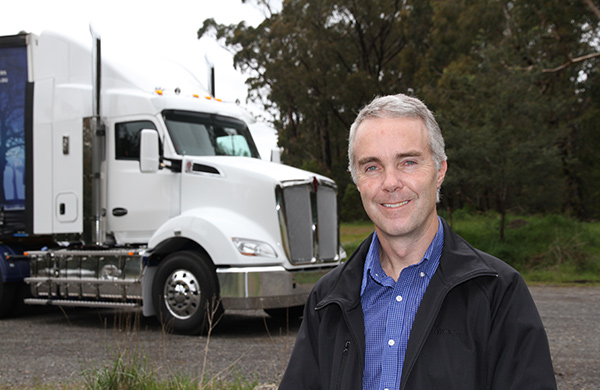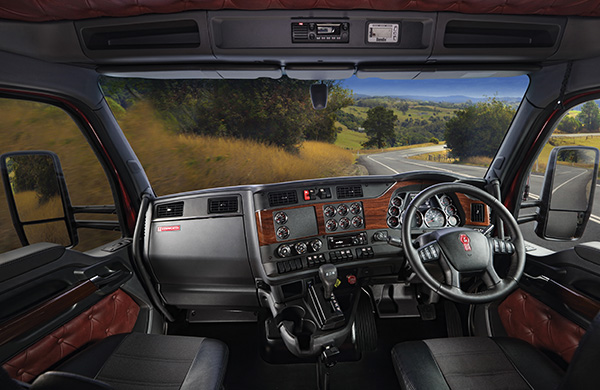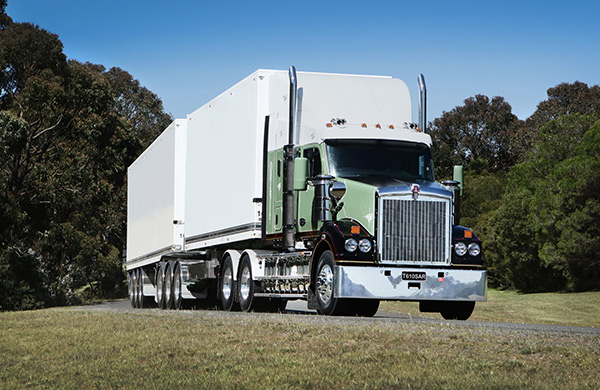Kenworth’s new T610 is the biggest and most expensive truck development program ever undertaken in the company’s Australian history. From Kenworth headquarters and behind the wheel, Steve Brooks files this detailed report
In the 40 years and more since Paccar first started building Kenworths at its renowned Bayswater (Vic) facility, there has been nothing quite like the new T610.
Sure, the first T600s in the mid-80s revolutionised the world of conventional truck design but in the 30 years since then, the actual structure of Kenworth conventionals with their 1.83 metre wide cab has changed very little. Until now!
In fact, senior Kenworth insiders say there is nothing in Paccar’s Australian history to even remotely match the investment made in the T610 with its 2.1 metre wide cab.
Word has it that by the time trucks start rolling out of Bayswater in February 2017, around $20 million will have been spent on an entirely new conventional truck engineered and built to the specific requirements of Australia and surrounding regions.
Some perspective on the extent of the investment in the T610 is perhaps best understood by the fact that the entire range of current 09 models (T409, T609, T909 etc) plus the radically revamped K200 cab-over all came to life for less than half of what will be spent on bringing the T610 into existence.
“This is the biggest single investment ever made in new Kenworth product in this country and outside Australia there is nothing like this truck anywhere in Paccar,” said a proud Brad May, Paccar Australia sales and marketing director.
“We basically took what we could from Paccar’s global platform but no one should be in any doubt that the engineering and design of the finished product are all ours, all done in Bayswater.”
Major cost items like the firewall and floor structures as well as a completely new and strengthened dash are uniquely Australian, fully engineered at Bayswater to achieve the structural durability and design goals deemed essential for this market.
“Our parent company obviously had to approve the investment and we certainly utilised Paccar’s facilities in the US in the durability validation process, but the engineering design is totally ours,” Brad May emphasised. “This is a truck engineered in Australia, for Australia. Absolutely!”
On the inside. The 2.1 metre wide cab provides a huge improvement in internal space along with full standing room in sleeper versions.
While external styling is definitely different and comes with a number of ancillary features adapted from the inventories of both Kenworth and Peterbilt in the US, the T610 is unquestionably an exercise in substance over style.
Most notably, the cab is wider, taller and in sleeper form, vastly more spacious and liveable than the long-serving cab of Kenworth’s current conventional range. Unlike existing T4 models, for example, sleeper versions of the 610 provide full standing room from the seat to the sleeper and there’s little doubt this fact alone will be a major attraction for owners and drivers alike.
For its initial assault on the market, Kenworth’s new T610 will immediately supersede the hugely successful T409 and its SAR derivative, but only those powered by the 15 litre Cummins ISXe5 engine.
The 610’s first foray into the market will see it offered in set-back and set-forward (SAR) front axle configurations, initially as a day cab or with an 860 mm (36 inch) sleeper. Of course, further sleeper options will be progressively added.
Meantime, ‘409s punched by Paccar’s own 13 litre MX engine will for the time being continue with the current 1.83 metre cab and existing sleeper options. It’s understood, however, that development work on an MX-powered version (T410) is already well under way.
Also check out our latest video of Steve Brooks driving the new Kenworth T900 Legend
As for other conventionals in the Kenworth range, the 2.1 metre cab is almost certain to be applied to all models in due course.
The T610 evolved from the conceptual possibilities provided by a US$400 million Paccar development program in the US around 2008 which ultimately saw the release of new Kenworth and Peterbilt models, notably the T680 and Pete 579.
Despite their fiercely held independence, the new Kenworth and Peterbilt models shared a new 2.1 metre wide cab. Realising the obvious potential of the wider cab, Australia’s product planning team were soon in touch with their US counterparts investigating the possibilities of a wider righthand-drive cab for the Australian market.
Access to the 15 litre Cummins is significantly improved but perhaps the biggest gain under the hood is a straight shaft to the steering box. Kenworth has also gone to an aluminium radiator for the big red engine.
As Brad May remarked, it was a long and highly detailed exercise and while a wider cab was seen as a ‘no-brainer’ for the next generation of Kenworth product, building a truck capable of enduring Australia’s operational and regulatory requirements was an all-consuming task.
Meantime, the hugely successful T409 with the Cummins 15 litre engine was seen from the outset as an ideal first candidate for the new cab. Evolving from the T600, the T4 family has grown to become the most versatile range in the Kenworth armoury.
There are, however, issues associated with the installation of a big bore engine into the relatively narrow confines of the existing 1.83 metre cab. Chief among those issues are a narrow driver’s footwell, awkward access to the bunk due to limited space and lack of standing room between the seats, complex steering geometry, and poor service access to the rear of engine, particularly the 15 litre Cummins.
Yet as a few hours behind the wheel of a pre-production unit quickly verified, the 2.1 metre cab of the T610 dramatically diminishes all these issues and in the case of steering geometry, completely negates concerns about complexity thanks to a straight shaft from the cab to the chassis-mounted steering box.
The T610 also provides a substantial (30%) increase in space around the driver’s footwell, the gap between the seats has been significantly opened and with a rise in the height of the bunk, there’s now room for an optional slide-out fridge. It’s actually amazing what Kenworth has achieved with an extra 270 mm between the B-pillars.
Meanwhile, floor height of the cab has been lifted by around 75 mm, adding another step for the climb in and out. However, the advantages of the higher floor are considerable.
Perhaps the greatest benefit is that it has allowed the cab to be moved forward to create a bumper to back-of-cab (BBC) dimension of just 112 inches on the day cab model, giving the newcomer particularly strong appeal for any number of length-critical applications. By comparison, the current T409 has a BBC of 116 inches.
Proud. Paccar Australia sales and marketing director Brad May.
Stayin’ Cool
Importantly, the higher stance of the cab allows greater airflow underneath to enhance cooling efficiency and considerably improves service access to the rear of the engine.
Furthermore, the taller cab also improves visibility though some drivers may rue the fact that the top of the KW ‘bug’ is no longer visible and therefore unavailable as a line of sight to the edge of the road. Kenworth insiders, however, are quick to point out that the bug remains visible over the snout of the SAR version.
Still, it’s almost certain some operators will question the cost-effectiveness of the T610’s single-piece windscreen over the two-piece ‘screen available on current T4s. For now though, Kenworth says it will be sticking with the single ‘screen.
However, it’s highly unlikely anyone will question the mirrors. Adapted from US models, they’re mounted on low slung dual arms and offer little visual interference on the approach to roundabouts and the like. They’re also incredibly strong as a Kenworth executive demonstrated by swinging his full weight from the mounting arm.
Under the hood, the T610 uses an aluminium radiator and an assertive Brad May says the new model has no difficulty cooling 600 hp at high loads and high ambient temperatures.
As for durability of the aluminium cooler, May says there have been no issues with the aluminium radiator used in MX-powered 409s and given the amount of testing done on the T610, Kenworth is entirely confident there won’t be any dramas with the new installation.
Furthermore, Kenworth is adamant that despite the bigger cab there has been no increase in tare weight due in large part to the use of aluminium wherever possible, not least in the radiator and the majority of the cab shell. It’s worth mentioning, however, the roof of sleeper cab models is made of a strong yet lightweight composite material.
Typically, quality and strength were high on the priority list with extensive engineering and test procedures put in place from the outset. One of those procedures was to ‘wire’ a T650 operating in roadtrain roles with Queensland-based livestock specialist Ross Fraser to electronically record a ‘drive file’ of real world and often severe road conditions for testing and engineering validation.
Dash Detail. Everything is new.
This data platform was the critical factor in creating what Brad May says is “The strongest cab we’ve ever built,” with test cabs enduring three times the normal cycle of shaker tests.
“No Kenworth cab has undergone greater durability assessment than the T610 and the whole structure stood up to everything put to it.
Meanwhile, back in Bayswater the cab was subjected to ECE R-29 crash standards and again came through with flying colours according to Brad May.
Likewise, the interior layout is a uniquely Australian design. For example, between the firewall and an injection moulded dash fascia which is said to be double the thickness of US designs, a totally new heating, ventilation and air-conditioning system was created for Australian conditions.
Additionally, the structural integrity of the dash and its underlying components are founded on what Kenworth describes as a purposely designed cross-car steel beam stretching across the width of the dash.
“A huge amount of time, effort and obviously money went into the dash and all the components attached to it. It was a complex exercise but we knew it had to be absolutely right,” Brad May remarked.
Visually, the dash is decidedly different but in typical Kenworth fashion, strong on function and form. The initial design sees a woodgrain fascia surrounding traditional gauges, with an optional multi-function touchscreen in the pipeline. Lower down and within relatively easy reach is a line of switches to a wide range of functions such as engine brake, diff lock and the like.
Meanwhile, switches for cruise control, audio, and menu functions for an LCD info display directly in front of the driver are mounted on the arms of a comfortably padded steering wheel.
Most prominent gauges are obviously the speedo and rev counter under the LCD screen. On each side are well positioned gauges and Kenworth points out that up to 18 gauges can be specified in the T610.
T610 SAR in Nolan’s colours. Note the external air cleaners.
Putting practicality first and certainly bucking the trend in automotive design are exposed fasteners holding the dash in place.
“The trend in automotive styling these days is to hide screws and fasteners,” Brad May explained. “But if something needs attention behind the dash, access is made a lot easier and there’s much less chance of damage by simply undoing a few easily reached screws to get behind the dash fascia.”
Surprisingly, cup holder trays on the lower edge of the dash centre differ between automated and manual transmissions. With a manual stick, the cup holder is neat and unobtrusive but automated versions have the ‘cobra’ shift controller mounted on a much larger assembly which extends notably into cab space.
In the lead-up to the launch of the T610, the first field evaluation unit went to work with high profile fleet McColl’s in June and over following months another four units – day cab and sleeper versions – hit the highways with various operators. Kenworth insists that by the time production trucks start rolling out of Bayswater, at least 11 pre-production T610s will be involved in ongoing field trials.
Trial results have been extraordinarily positive says Brad May, adding that the years of careful planning, local engineering and design experience, and brutal test procedures have driven high levels of confidence that Kenworth’s latest will also be its greatest.
“The T610 is home-grown and we are already incredibly proud of what we’ve achieved with this truck,” he said earnestly. “Yes, we’re extremely confident but then, I think we have good reason to be.
“After all, the T610 is the latest evolution of what we’ve been doing in this country for 40 years. Building trucks for Australia.”














